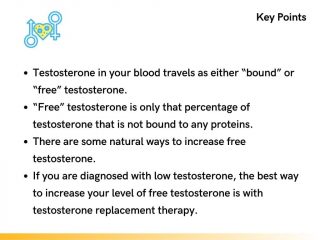 On this page, we will take a comprehensive look at the safest and most effective ways to increase your free testosterone.
On this page, we will take a comprehensive look at the safest and most effective ways to increase your free testosterone.
Free testosterone refers to the portion of testosterone in the bloodstream that is not bound to proteins, such as sex hormone-binding globulin (SHBG) or albumin.
Testosterone is the primary male hormone or androgen, but women’s bodies make and need testosterone as well. The majority of the testosterone in your body is protein-bound and is not available for use. A lesser amount of testosterone can be found circulating in the bloodstream as unbound or “free” testosterone. While free testosterone makes up a much smaller percentage of your total testosterone than bound, it is more important because that is the testosterone that is available for your body to use.
Understanding Free Testosterone and Its Significance
As stated earlier, most of the testosterone in your blood is bound to two proteins, albumin, and SHBG. Some testosterone is not attached to these proteins or is “free.” This is the testosterone that is easily used by your body.
Testosterone is critical for your health. Testosterone is a critical hormone for both men and women. Unfortunately, we lose this critical hormone as we age. This age-related testosterone loss can be a real issue, especially leading to issues related to low testosterone.
Free testosterone is the amount of testosterone that is unbound or available to use in your blood. Since this is the source of available testosterone, that is why so important for both men and women to understand how to safely increase your free testosterone level.
Free Testosterone: Definition and Function
When testosterone is produced by the testes in males or the ovaries and adrenal glands in females, it circulates in the bloodstream. However, a significant portion of testosterone becomes bound to proteins, particularly SHBG. This bound testosterone is considered inactive because it cannot easily interact with target tissues and exert its biological effects.
On the other hand, free testosterone represents the unbound, biologically active form of the hormone. It is readily available to interact with androgen receptors in various tissues throughout the body, including muscle cells, bone cells, and the brain. Free testosterone is responsible for many of the physiological functions associated with testosterone, such as promoting muscle growth, bone density, and sexual function.
How to Increase Free Testosterone in Males
It can be particularly important for men to learn ways that they can raise their free testosterone levels. This can be done through diet, exercise, and other lifestyle changes.
Diet and Nutrition for Boosting Free Testosterone

If you want to naturally increase your testosterone levels, foods you should add to your diet right now include:
- Tuna and other oily fish, such as sardines and salmon
- Low-fat milk with vitamin D
- Egg yolks
- Fortified whole-grain cereals
- Oysters
- Shellfish
- Beef
- Beans
Foods to Avoid to Increase Your Free Testosterone
If you want to boost testosterone in addition to adding foods, there are certain “testosterone-killing” foods you must avoid. These include:
- Soy products
- Most dairy products (except those that have been enriched with vitamin D)
- Mint
- Bread, pastries, and desserts
- Licorice root
- Vegetable Oil
- Flaxseed
- Processed Foods
Generally speaking, a “heart-healthy” diet, one that is high in protein and low in carbs and fats, is the best to also maintain good testosterone levels.
Exercise and Strength Training
Exercise is one of the most effective ways to boost your testosterone. Strength training, such as weightlifting or High-Intensity Interval Training, are the best exercises to boost testosterone. Such exercises also boost your level of growth hormone. Exercise can also help you to lose weight. Obesity lowers your testosterone level.
Lifestyle Factors and Habits
Making certain lifestyle changes, such as not smoking, eliminating or reducing your consumption of alcohol, and getting adequate sleep, can all raise your free testosterone level.
How to Increase Free Testosterone in Females
Women also should know how to increase their free or bioavailable testosterone levels. This is particularly important because women’s bodies need so much less testosterone than men’s. Making the right choices to increase testosterone could be all they need to make up for their natural loss of testosterone.
Nutrition and Dietary Choices for Females

Women should be sure to consume adequate amounts of protein, as protein is essential for the production of testosterone. Include high-quality sources of protein in your diet, such as lean meats, fish, eggs, dairy products, and legumes. Females should also be sure to eat healthy fats such as avocados, nuts, seeds, and olive oil. Healthy fats are important for hormone production, including testosterone.
Exercise and Physical Activity
Just as in men, exercise and physical activity are essential to boost free testosterone levels. Women should endeavor to maintain a healthy weight and engage in regular physical activity. Incorporate strength training exercises as they have been shown to be particularly effective in boosting testosterone.
Additional Approaches for Increasing Free Testosterone in Both Males and Females
Natural Supplements and Herbs
There are some herbs and supplements that can help raise testosterone in both men and women. The most important of these is vitamin D. Vitamin D deficiency has been associated with decreased testosterone levels. Spend time outdoors in the sunlight, especially during midday, to allow your body to naturally synthesize vitamin D. If necessary, consider taking a vitamin D supplement after consulting with your healthcare provider. Some herbal supplements, such as ashwagandha and fenugreek, have shown the potential to support healthy testosterone levels.
Stress Reduction Techniques
Stress raises cortisol levels, and cortisol is a testosterone killer. The higher your cortisol, the lower your testosterone. You can maintain healthier testosterone levels by practicing some stress reduction techniques such as deep breathing, yoga, meditation, or Tai Chi.
Hormone Replacement Therapy
As mentioned above, there are ways to naturally boost your free testosterone levels. However, if you have been diagnosed with low testosterone – particularly for males over 35 — the only way to treat it is with testosterone replacement therapy.
Exercising more, eating the foods as suggested, and making other lifestyle changes can all help to boost free testosterone levels. But, at a certain age, your body can only produce so much testosterone. If you are over 40 and experiencing the symptoms of low testosterone, chances are you can never raise your levels high enough with lifestyle changes alone.
Testosterone replacement therapy is a safe and effective way for men with below-normal testosterone levels to improve their quality of life. The only way to legally obtain testosterone therapy is with a proper diagnosis of low testosterone and a prescription from a doctor.
Conclusion
Measuring free testosterone levels can be helpful in assessing an individual’s hormonal status, particularly in cases where low testosterone symptoms are present, such as decreased libido, fatigue, or muscle weakness. It provides an indication of the amount of biologically active testosterone available for use by the body.
While you can raise your free testosterone levels naturally by adopting the lifestyle changes mentioned above, if you are a man who has been diagnosed with low testosterone and is experiencing the symptoms of low testosterone, the only way to alleviate the problem is with testosterone replacement therapy as prescribed by the doctors in our clinics.

